The lenses we use
Moderators: rjlittlefield, ChrisR, Chris S., Pau
-
ray_parkhurst
- Posts: 3431
- Joined: Sat Nov 20, 2010 10:40 am
- Location: Santa Clara, CA, USA
- Contact:
- rjlittlefield
- Site Admin
- Posts: 23597
- Joined: Tue Aug 01, 2006 8:34 am
- Location: Richland, Washington State, USA
- Contact:
Ray, here are the images that I promised you, regarding full frame versus APS at same pixel size.
To begin, here’s the FOV and surroundings. The test subject is a high-resolution USAF chart from Edmund Optics, with a piece of moth wing and a small ruler sitting on it. Illumination is mixed: front lighting for the moth wing and backlight for the chrome-on-glass USAF chart. I’ve marked the approximate FOV in this image.
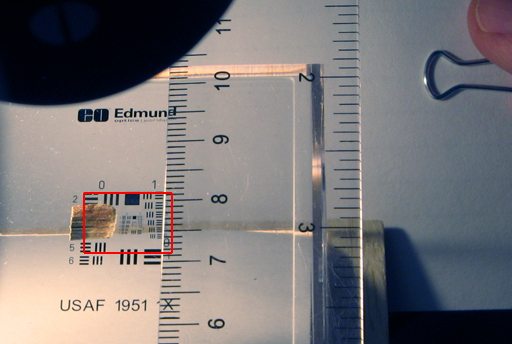
For the camera setup, I’m using Nikon D800E with f50 mm /2.8 Schneider-Kreuznach Componon S, reversed on bellows and set on f/4. Electronic flash illumination at lowest power, with paper for diffusion and ND filtering.
There are two configurations: one at higher magnification, about 3.2X, that fills the full-frame sensor with the FOV; and a second at lower magnification, about 1.9X, that fits the FOV to an APS-sized portion of the same sensor. What we’re going to look at is the same FOV, imaged using the same lens, on full frame and APS with the same pixel size. Of course the pixel count is much larger for the full frame.

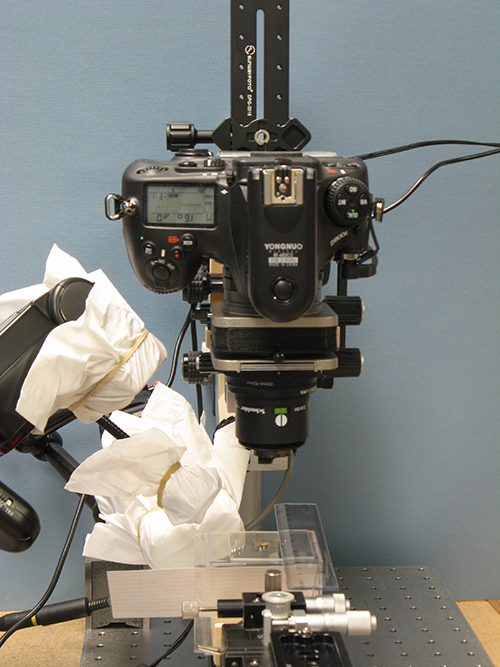
Here is the FOV as seen by the camera in both cases:
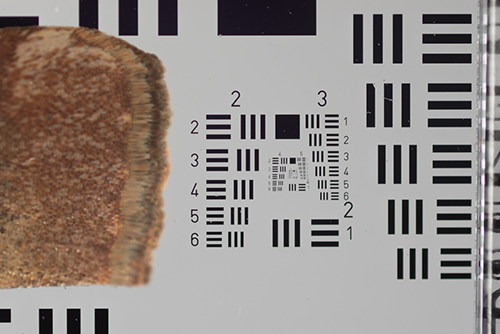
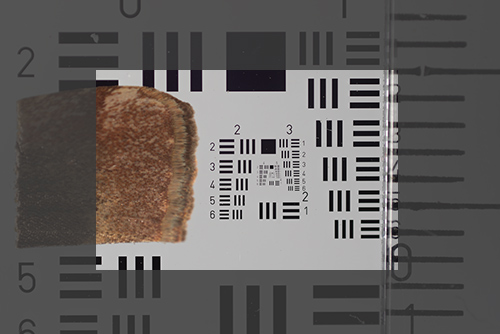
When the whole FOV is blown up and reproduced at the same size at web resolution, there is no visible difference between these two captures. I won’t bother to show that.
But let’s see which one holds up better to zooming. I’ve chosen two crops of important areas on the subject. One is the high resolution central portion of the USAF chart, and the other is an interesting section of the moth wing.
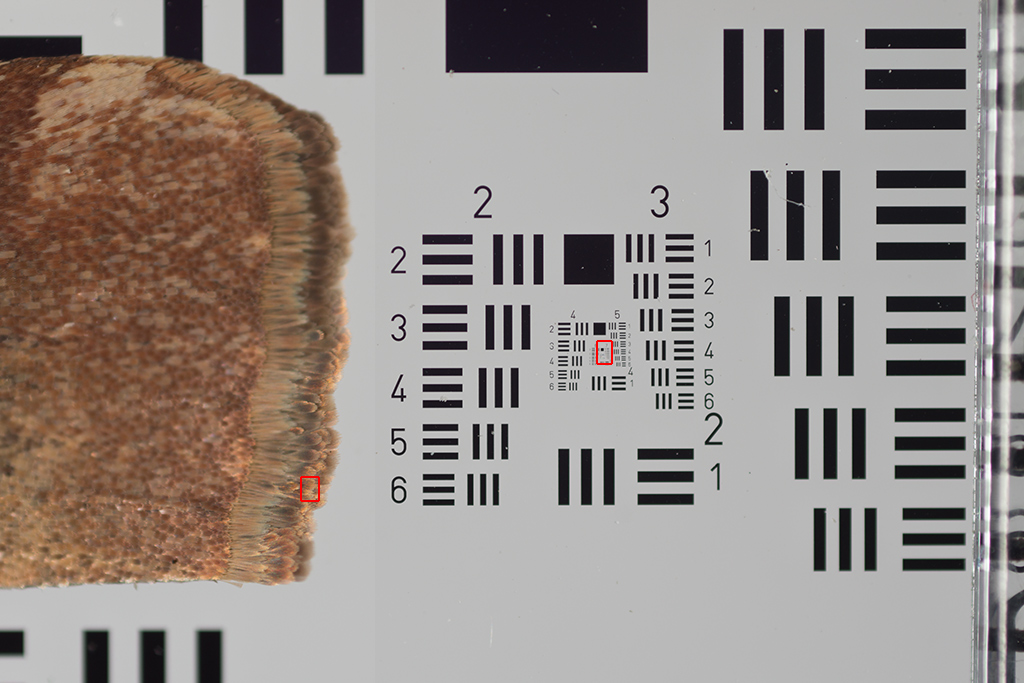
To make the comparison easy to evaluate, I’m going to zoom way in. I’ve used integer zoom factors and nearest neighbor resampling, so you don’t have to worry about any sort of smoothing effects.
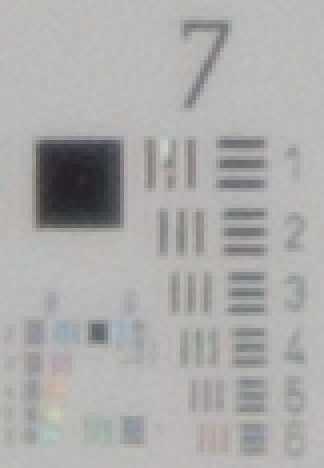
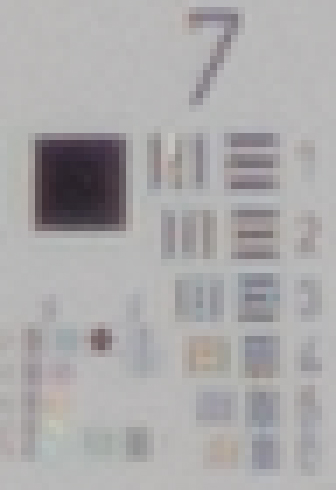
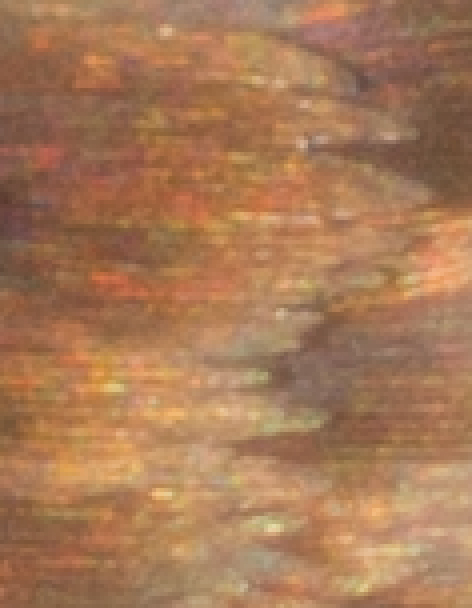
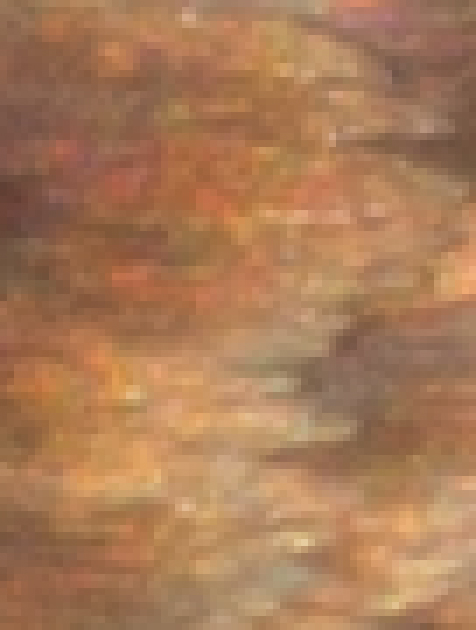
Now, unless I’m looking at totally different images from you, it should be clear that the images on the left show far more detail than the ones on the right. Fine striations in the scales are visible in one and not the other, and the USAF chart resolves three more elements.
The images on the left, of course, are the ones that come from using the full frame. Those have a sampling size on subject that’s about 1.67 times smaller, so they capture more detail.
To recap: more pixels hold up better to zooming in, until you get down to an FOV so small that both sensor sizes will be able to capture all the information in the optical image. The demonstration here was over an FOV that’s about 7.5 x 11.3 mm, rather smaller than the average coin, and using a pretty mundane lens. With good optics and a larger FOV, the difference would be even more obvious.
The above shows the sort of advantage that you gave away when you returned the 5DSR and went back to using your HRT2i.
Hence my puzzlement: if your goal remains to to make images of coins that stand up as well as possible to zooming in, without having to stitch, then why did you return that 5DSR?
--Rik
Further technical details… Single frames selected from focus stacks at 20 micron spacing, shot as NEF, developed in Adobe Camera Raw with exposure correction to compensate for the brighter image at lower magnification. Pixel enlargement factors for the zoom are 400% and 700%.
To begin, here’s the FOV and surroundings. The test subject is a high-resolution USAF chart from Edmund Optics, with a piece of moth wing and a small ruler sitting on it. Illumination is mixed: front lighting for the moth wing and backlight for the chrome-on-glass USAF chart. I’ve marked the approximate FOV in this image.

For the camera setup, I’m using Nikon D800E with f50 mm /2.8 Schneider-Kreuznach Componon S, reversed on bellows and set on f/4. Electronic flash illumination at lowest power, with paper for diffusion and ND filtering.
There are two configurations: one at higher magnification, about 3.2X, that fills the full-frame sensor with the FOV; and a second at lower magnification, about 1.9X, that fits the FOV to an APS-sized portion of the same sensor. What we’re going to look at is the same FOV, imaged using the same lens, on full frame and APS with the same pixel size. Of course the pixel count is much larger for the full frame.


Here is the FOV as seen by the camera in both cases:


When the whole FOV is blown up and reproduced at the same size at web resolution, there is no visible difference between these two captures. I won’t bother to show that.
But let’s see which one holds up better to zooming. I’ve chosen two crops of important areas on the subject. One is the high resolution central portion of the USAF chart, and the other is an interesting section of the moth wing.

To make the comparison easy to evaluate, I’m going to zoom way in. I’ve used integer zoom factors and nearest neighbor resampling, so you don’t have to worry about any sort of smoothing effects.




Now, unless I’m looking at totally different images from you, it should be clear that the images on the left show far more detail than the ones on the right. Fine striations in the scales are visible in one and not the other, and the USAF chart resolves three more elements.
The images on the left, of course, are the ones that come from using the full frame. Those have a sampling size on subject that’s about 1.67 times smaller, so they capture more detail.
To recap: more pixels hold up better to zooming in, until you get down to an FOV so small that both sensor sizes will be able to capture all the information in the optical image. The demonstration here was over an FOV that’s about 7.5 x 11.3 mm, rather smaller than the average coin, and using a pretty mundane lens. With good optics and a larger FOV, the difference would be even more obvious.
The above shows the sort of advantage that you gave away when you returned the 5DSR and went back to using your HRT2i.
Hence my puzzlement: if your goal remains to to make images of coins that stand up as well as possible to zooming in, without having to stitch, then why did you return that 5DSR?
--Rik
Further technical details… Single frames selected from focus stacks at 20 micron spacing, shot as NEF, developed in Adobe Camera Raw with exposure correction to compensate for the brighter image at lower magnification. Pixel enlargement factors for the zoom are 400% and 700%.
-
Justwalking
- Posts: 137
- Joined: Sun Jun 10, 2018 3:54 pm
- Location: Russia
Not lot, but I see that some small details absent with TC and contrast is lower. F eff was about 10 without TC.ray_parkhurst wrote:Other than the WB shift, I don't see a whole lot of change between the images.
What is the effective aperture of your non-TC image?
edited to add: I am also not sure about the effect of a 1.5x TC mag. Seems that it should improve things, but not as much as 2x.
-
ray_parkhurst
- Posts: 3431
- Joined: Sat Nov 20, 2010 10:40 am
- Location: Santa Clara, CA, USA
- Contact:
Rik...thanks for taking the time to show this comparison. It indeed shows that the FF camera allows more zooming-in versus the APS-C, as was expected.rjlittlefield wrote:Ray, here are the images that I promised you, regarding full frame versus APS at same pixel size.
snip
To make the comparison easy to evaluate, I’m going to zoom way in. I’ve used integer zoom factors and nearest neighbor resampling, so you don’t have to worry about any sort of smoothing effects.
Now, unless I’m looking at totally different images from you, it should be clear that the images on the left show far more detail than the ones on the right. Fine striations in the scales are visible in one and not the other, and the USAF chart resolves three more elements.
The images on the left, of course, are the ones that come from using the full frame. Those have a sampling size on subject that’s about 1.67 times smaller, so they capture more detail.
To recap: more pixels hold up better to zooming in, until you get down to an FOV so small that both sensor sizes will be able to capture all the information in the optical image. The demonstration here was over an FOV that’s about 7.5 x 11.3 mm, rather smaller than the average coin, and using a pretty mundane lens. With good optics and a larger FOV, the difference would be even more obvious.
The above shows the sort of advantage that you gave away when you returned the 5DSR and went back to using your HRT2i.
Hence my puzzlement: if your goal remains to to make images of coins that stand up as well as possible to zooming in, without having to stitch, then why did you return that 5DSR?
snip
Pixel enlargement factors for the zoom are 400% and 700%.
Based on your last post, I was expecting something different from these images. I had posted this:
"Now, you mentioned in earlier post that monochrome targets should be nearly full resolution. Yet if I shoot a "monochrome" Ag coin with a 2x teleconverter, and then downsize 2x, I get a sharper image compared with shooting without a teleconverter. This tells me that the sensor at pixel level is not really full resolution. Or am I missing something? This is fundamental to my quest so important to understand fully."
You responded to the "Or am I missing something?" and said you'd take some photos to explain. But your photos don't talk to the specifics of my question, which remains unanswered. What can I glean from your comparison that helps me with understanding what is causing the unsharpness at 100%, and how to improve upon it?
As I explained, I'm looking for "more" than just the improved resolution due to higher pixel count/larger sensor. I'm also looking for some solution to the unsharpness at 100%, which is inevitably the zoom factor most used by folks for comparisons. The 5DSR and A7RIII promised improved 100% sharpness, but did not deliver. Maybe no cameras can? Or perhaps I need to look into this from technique perspective and think about super-resolution or other?
I have a nagging feeling that some cameras do better at 100% resolution than others, but so far no direct evidence.
-
ray_parkhurst
- Posts: 3431
- Joined: Sat Nov 20, 2010 10:40 am
- Location: Santa Clara, CA, USA
- Contact:
Forgot to ask...was this taken with the CCD sensor camera with ~2um pixels? If so, then f10 on that small a pixel cannot really be improved much with the TC technique.Justwalking wrote:Not lot, but I see that some small details absent with TC and contrast is lower. F eff was about 10 without TC.ray_parkhurst wrote:Other than the WB shift, I don't see a whole lot of change between the images.
What is the effective aperture of your non-TC image?
edited to add: I am also not sure about the effect of a 1.5x TC mag. Seems that it should improve things, but not as much as 2x.
-
Justwalking
- Posts: 137
- Joined: Sun Jun 10, 2018 3:54 pm
- Location: Russia
It is Cmos sensor camera with ~1.3um. This samples crop is about 1.5mm size.ray_parkhurst wrote:
Forgot to ask...was this taken with the CCD sensor camera with ~2um pixels? If so, then f10 on that small a pixel cannot really be improved much with the TC technique.
Ray, as i understand this is your great site and your article about TC.
http://coinimaging.com/teleconverter.html
Last edited by Justwalking on Tue Aug 07, 2018 7:19 am, edited 1 time in total.
- rjlittlefield
- Site Admin
- Posts: 23597
- Joined: Tue Aug 01, 2006 8:34 am
- Location: Richland, Washington State, USA
- Contact:
Not much, and that was not the point of my posting.ray_parkhurst wrote:What can I glean from your comparison that helps me with understanding what is causing the unsharpness at 100%, and how to improve upon it?
Let me replay the entire post that you have quoted a bit of, and this time I'll highlight the parts that I was responding to.
When I wrote "Yes, I think you are," I was responding to those assertions in bold face.ray_parkhurst wrote:Rik...indeed, the goal has not changed. However, the limitation I have found is not resolution per se, but the image quality at 100% crops. What good does it do to zoom-in to blurry 100% crops? This is the reason I have been considering and testing these pixel-shifting and 'fine detail' cameras, and have even considered the Sigma.rjlittlefield wrote:At one point, sometime around that phone conversation I mentioned, I thought I understood that your goal was to make images of coins that would stand up as well as possible to zooming in, without having to stitch.
Now, you mentioned in earlier post that monochrome targets should be nearly full resolution. Yet if I shoot a "monochrome" Ag coin with a 2x teleconverter, and then downsize 2x, I get a sharper image compared with shooting without a teleconverter. This tells me that the sensor at pixel level is not really full resolution. Or am I missing something? This is fundamental to my quest so important to understand fully.
As I read your words, you were saying that adding pixels would not help because they would just be blurry. That belief would certainly explain why you returned the 5DSR, but the belief is wrong.
So, the goal of my posting was to convince you that in fact adding pixels does help, for subjects of a size that you care about, and with a lens that is far inferior to stuff in your kit.
Apparently that goal was met, because you now assert that the outcome I showed was "expected" -- more pixels reveals more detail on subject.
But then I asked again, why did you return the 5DSR? And you've answered that you want "more".
So now I'm thinking that your goal is not actually to get more resolution on subject, but rather to understand why 100% views don't look sharp.
Does that sound like that you're looking for?
--Rik
- rjlittlefield
- Site Admin
- Posts: 23597
- Joined: Tue Aug 01, 2006 8:34 am
- Location: Richland, Washington State, USA
- Contact:
No, I did not have that impression. No apology is needed.mjkzz wrote:I raised that "imperfect" lens thing NOT to say "you screwed up" the experiment, if you had that impression,
My point was that in suggesting the lens was imperfect, you were actually undercutting your own argument. To support your argument would have required something completely different, for example a mistake in setting up the experiment that could have caused the aperture to be wider than claimed.
The key words are on the surface. If you went at all below the surface, and just did the algebra, starting from formulas that you apparently already accept, then it should have been clear that the cutoff wavelength occurs at Airy disk diameter divided by 2.44. In turn, that immediately implies that you need 4.88 samples per Airy disk diameter, not 2 as you keep asserting.I meant, according to the formula of MFT in form of angle, calculation of f(c) or the cutoff frequency has nothing to do with airy disk, at least on surface.
To be blunt, I have had the feeling that you are so strongly invested in the idea that 2 pixels per Airy disk diameter is enough, that you simply turn your eyes away from all evidence to the contrary, including your own math.
Yes, the image on a sensor selected according to Nikon's rule will definitely be diffraction-limited. That's the point. If the image is not diffraction-limited on a given sensor, then sensor limitations have failed to capture all the image content.Plus, as f(c) implies and in agreement with your assessment, the pixel size (half of cutoff wavelength) derived from cutoff frequency and sampling theorem will put it in the diffraction zone and image pulled from such system will be diffraction-limited.
I am repeating myself now, but that's nothing new in this discussion.
What Nikon's strategy does is to place two pixels per cycle at the cutoff wavelength. This is the absolute minimum requirement to catch all the content. It does not catch all the content very well. As shown HERE, using only two pixels per line pair is not enough to get an accurate capture. That takes more like 4 pixels per line pair. So, Nikon is meeting the minimum requirements of optics and Nyquist, but still without getting an accurate capture for the finest details.
On the other hand, putting two pixels per line pair at the cutoff wavelength also implies putting four pixels per line pair at double that cutoff wavelength. If you slog through the MTF formulas, you'll find that MTF for double the cutoff wavelength is just over 39%.
So, while it's true that Nikon's formula does not do a very good job for fine detail (2 pixels per line pair), it does do a good job (4 pixels per line pair) for coarser detail where diffraction allows 39% MTF or higher. This is why I've come to think that their approach is an excellent compromise.
--Rik
-
ray_parkhurst
- Posts: 3431
- Joined: Sat Nov 20, 2010 10:40 am
- Location: Santa Clara, CA, USA
- Contact:
Rik...I am looking for improvements in both aspects of the output image. I know that I can get more resolution, and thus a larger image which can stand up to more zooming-in, by going to a larger sensor just by "writing a check". But once zoomed-in, I want the image to be sharp.rjlittlefield wrote:So, the goal of my posting was to convince you that in fact adding pixels does help, for subjects of a size that you care about, and with a lens that is far inferior to stuff in your kit.
Apparently that goal was met, because you now assert that the outcome I showed was "expected" -- more pixels reveals more detail on subject.
But then I asked again, why did you return the 5DSR? And you've answered that you want "more".
So now I'm thinking that your goal is not actually to get more resolution on subject, but rather to understand why 100% views don't look sharp.
Does that sound like that you're looking for?
--Rik
Downsizing the images you posted by their zoom factors to get back to what I presume they look like at 100%, I get these:


Interestingly, with these coming from the same camera/sensor and processing, the full resolution one looks sharper than the lower resolution one, but it shouldn't, right? They also don't look like they are scaled properly vs the expected resolution ratio. I presume something in processing of up/downsizing has caused differences between the images. Would you please simply crop the same image size (not FOV) from the two source images and post?
- rjlittlefield
- Site Admin
- Posts: 23597
- Joined: Tue Aug 01, 2006 8:34 am
- Location: Richland, Washington State, USA
- Contact:
Your scaling went wrong somehow. The same-FOV image from the APS frame should have been about 0.6 the size of the full frame, not 0.86 as you have them.ray_parkhurst wrote:Interestingly, with these coming from the same camera/sensor and processing, the full resolution one looks sharper than the lower resolution one, but it shouldn't, right? They also don't look like they are scaled properly vs the expected resolution ratio. I presume something in processing of up/downsizing has caused differences between the images. Would you please simply crop the same image size (not FOV) from the two source images and post?
Here are simple crops, montaged and saved as PNG to eliminate any concerns about JPEG compression.
--Rik
-
Justwalking
- Posts: 137
- Joined: Sun Jun 10, 2018 3:54 pm
- Location: Russia
For correct zoom second photo must be 90pix in high compared to first 152px (152/ (3.2/1.9))ray_parkhurst wrote:
Interestingly, with these coming from the same camera/sensor and processing, the full resolution one looks sharper than the lower resolution one, but it shouldn't, right? They also don't look like they are scaled properly vs the expected resolution ratio.
-
ray_parkhurst
- Posts: 3431
- Joined: Sat Nov 20, 2010 10:40 am
- Location: Santa Clara, CA, USA
- Contact:
OK, that looks better, thanks. Both look about as sharp, but of course the FOV is smaller and there is more detail on the higher resolution sensor.rjlittlefield wrote: Your scaling went wrong somehow. The same-FOV image from the APS frame should have been about 0.6 the size of the full frame, not 0.86 as you have them.
Here are simple crops, montaged and saved as PNG to eliminate any concerns about JPEG compression.
--Rik
It's tough for me to judge "how sharp" these are as I don't look at butterfly wings that often.
- rjlittlefield
- Site Admin
- Posts: 23597
- Joined: Tue Aug 01, 2006 8:34 am
- Location: Richland, Washington State, USA
- Contact:
It's hard to judge sharpness when the image content obviously varies.ray_parkhurst wrote:Both look about as sharp
To simplify your task, here is an isolated edge, scaled to 400% by nearest-neighbor, and stored as PNG:
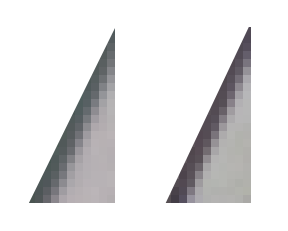
For context, that edge comes from the slanted bar of the big "4" at lower right:
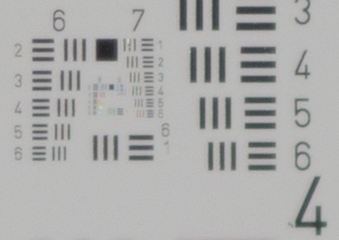
You keep saying "of course", but you sent back that 5DSR. I'm still struggling to understand that combination.of course ... there is more detail on the higher resolution sensor.
--Rik
-
Justwalking
- Posts: 137
- Joined: Sun Jun 10, 2018 3:54 pm
- Location: Russia
- rjlittlefield
- Site Admin
- Posts: 23597
- Joined: Tue Aug 01, 2006 8:34 am
- Location: Richland, Washington State, USA
- Contact:
I'm not sure whether you are asking a question or making a statement.Justwalking wrote:So for the same FoV how we can get more detail? By higher resolution sensor. It is mean we need less pixel pitch size.
In this demonstration, the physical pixel pitch size remained the same.
But for the larger sensor, we increased the magnification. That increased the size of the Airy disk, so the pixels did become smaller with respect to the Airy disk.
Another way of looking at it is that the optical image is under-resolved at the lower magnification. By making the image larger, we effectively sample it more densely with the same size pixels.
Does that help?
--Rik
